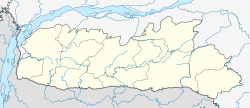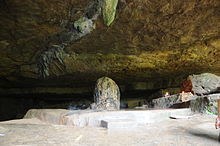This is an old revision of this page, as edited by 209.232.148.100 (talk) at 21:06, 14 April 2022. The present address (URL) is a permanent link to this revision, which may differ significantly from the current revision.
Revision as of 21:06, 14 April 2022 by 209.232.148.100 (talk)(diff) ← Previous revision | Latest revision (diff) | Newer revision → (diff)Town in Meghalaya, India
| Mawsynram | |
|---|---|
| Town | |
  | |
| Coordinates: 25°17′N 91°21′E / 25.28°N 91.35°E / 25.28; 91.35 | |
| Country | |
| State | Meghalaya |
| District | East Khasi Hills |
| Talukas | Mawsynram C.D. Block |
| Area | |
| • Total | 2,788 km (1,076 sq mi) |
| Languages | |
| • Official | English, Khasi |
| Time zone | UTC+5:30 (IST) |
| PIN | 793113 |
| Telephone code | 03673 |
| Vehicle registration | ML |
| Nearest city | Shillong |
| Climate | Cwb |
Location
| Mawsynram | ||||||||||||||||||||||||||||||||||||||||||||||||||||||||||||
|---|---|---|---|---|---|---|---|---|---|---|---|---|---|---|---|---|---|---|---|---|---|---|---|---|---|---|---|---|---|---|---|---|---|---|---|---|---|---|---|---|---|---|---|---|---|---|---|---|---|---|---|---|---|---|---|---|---|---|---|---|
| Climate chart (explanation) | ||||||||||||||||||||||||||||||||||||||||||||||||||||||||||||
| ||||||||||||||||||||||||||||||||||||||||||||||||||||||||||||
| ||||||||||||||||||||||||||||||||||||||||||||||||||||||||||||
Mawsynram is located at 25° 18′ N, 91° 35′ E, at an altitude of about 1,400 metres (4,600 ft), 15 km west of Cherrapunji, in the Khasi Hills in the state of Meghalaya (India).
Climate and rainfall
Under the Köppen climate classification, Mawsynram features a subtropical highland climate (Cwb) with an extraordinarily showery, rainy and long monsoonal season and a short dry season. Based on the data of a recent few decades, it appears to be the wettest place in the world, or the place with the highest average annual rainfall. Mawsynram receives over 10,000 millimeters of rain in an average year, and the vast majority of the rain it gets falls during the monsoon months. A comparison of rainfalls for Cherrapunji and Mawsynram for some years is given in Table 1. Mawsynram receives the highest rainfall in India. Although it is reportedly the wettest place on Earth, with an average annual rainfall of 11,872 millimetres (467.4 in), this claim is disputed by Lloró, Colombia, which reported an average yearly rainfall of 12,717 millimetres (500.7 in) between 1952 and 1989 and López de Micay, also in Colombia, which reported 12,892 mm (507.6 in) per year between 1960 and 2012.
| Climate data for Mawsynram | |||||||||||||
|---|---|---|---|---|---|---|---|---|---|---|---|---|---|
| Month | Jan | Feb | Mar | Apr | May | Jun | Jul | Aug | Sep | Oct | Nov | Dec | Year |
| Mean daily maximum °C (°F) | 15.5 (59.9) |
16.8 (62.2) |
20.7 (69.3) |
22.1 (71.8) |
22.5 (72.5) |
22.3 (72.1) |
22.4 (72.3) |
22.9 (73.2) |
22.8 (73.0) |
22.0 (71.6) |
19.2 (66.6) |
16.6 (61.9) |
20.5 (68.9) |
| Daily mean °C (°F) | 11.2 (52.2) |
12.8 (55.0) |
16.5 (61.7) |
18.4 (65.1) |
19.2 (66.6) |
19.9 (67.8) |
20.2 (68.4) |
20.4 (68.7) |
20.3 (68.5) |
18.6 (65.5) |
15.2 (59.4) |
12.3 (54.1) |
17.1 (62.8) |
| Mean daily minimum °C (°F) | 6.9 (44.4) |
8.8 (47.8) |
12.3 (54.1) |
14.7 (58.5) |
15.9 (60.6) |
17.5 (63.5) |
18.0 (64.4) |
18.0 (64.4) |
17.8 (64.0) |
15.3 (59.5) |
11.2 (52.2) |
8.0 (46.4) |
13.7 (56.7) |
| Average precipitation mm (inches) | 17 (0.7) |
30 (1.2) |
163 (6.4) |
451 (17.8) |
1,083 (42.6) |
2,348 (92.4) |
2,467 (97.1) |
1,714 (67.5) |
853 (33.6) |
338 (13.3) |
52 (2.0) |
11 (0.4) |
9,527 (375.1) |
| Source: (year rain) | |||||||||||||
Primarily due to the high altitude, it seldom gets truly hot in Mawsynram. Average monthly temperatures range from around 11 °C in January to just above 20 °C in August. The village also experiences a brief but noticeably drier season from December until February, when monthly precipitation on average does not exceed 30 millimetres (1.2 in). The little precipitation during the village's "low sun" season is something that is shared by many areas with this type of climate.
The following table is a comparison of rainfalls for Cherrapunji and Mawsynram between 1970 and 2010.
| Year | Cherrapunji Rainfall (mm) | Mawsynram Rainfall (mm) |
|---|---|---|
| 2010 | 13 472 | 14 234 |
| 2009 | 9 070 | 12 459 |
| 2008 | 11 415 | 12 670 |
| 2007 | 12 647 | 13 302 |
| 2006 | 8 734 | 8 082 |
| 2005 | 9 758 | 10 072 |
| 2004 | 14 791 | 14 026 |
| 2003 | 10 499 | 11 767 |
| 2002 | 12 262 | 11 118 |
| 2001 | 9 071 | 10 765 |
| 2000 | 11 221 | 13 561 |
| 1999 | 12 503 | 13 445 |
| 1998 | 14 536 | 16 720 |
| 1997 | 8 993 | 9 892 |
| 1996 | 12 989 | 12 850 |
| 1995 | 14 189 | 13 832 |
| 1994 | 11 194 | 10 940 |
| 1993 | 12 807 | 13 848 |
| 1992 | 8 537 | 10 450 |
| 1991 | 13 494 | 16 112 |
| 1990 | 11 598 | 12 934 |
| 1989 | 13 432 | 8 828 |
| 1988 | 17 948 | 16 750 |
| 1987 | 13 153 | NA |
| 1986 | 8 140 | NA |
| 1985 | 11 816 | 26 000 |
| 1984 | 16 761 | 25 613 |
| 1983 | 9 773 | 12 163 |
| 1982 | 10 468 | 9 246 |
| 1981 | 9 113 | 9 739 |
| 1980 | 9 133 | 9 739 |
| 1979 | 12 095 | NA |
| 1978 | 6 950 | NA |
| 1977 | 11 689 | 11 986 |
| 1976 | 11 012 | 6 134 |
| 1975 | 11 976 | 10 639 |
| 1974 | 24 554 | NA |
| 1973 | 10 911 | NA |
| 1972 | 11 095 | NA |
| 1971 | 16 915 | NA |
| 1970 | 15 318 | NA |

Three reasons can be cited for high rainfall at Mawsynram:
- The warm moist winds of the northward-moving air from the Bay of Bengal during the monsoon, which cover an extensive area but are forced to converge into the narrower zone over the Khasi Hills, thus concentrating their moisture.
- The alignment of the Khasi Hills (east to west) places them directly in the path of the airflow from the Bay of Bengal, producing a significant uplift (plus cooling, further condensation and thus more rain).
- Finally, uplift over the Khasi Hills is virtually continuous in the monsoon period because the lifted air is constantly being pulled up by vigorous winds in the upper atmosphere; hence, the rainfall is more or less continuous.
Natural landmarks
Located in Mawsynram, is a cave named Mawjymbuin, known for its stalagmites. Inside this cave is a pair of notable speleothems - stalactites shaped like a cow's udder over a large stalagmite. The area is known for its many caves, both commercialized and non-commercialized.
References
- Kuttippurath, J; Murasingh, S; Stott, P A; Sarojini, B Balan; Jha, Madan K; Kumar, P; Nair, P J; Varikoden, H; Raj, S; Francis, P A; Pandey, P C (22 January 2021). "Observed rainfall changes in the past century (1901–2019) over the wettest place on Earth". Environmental Research Letters. 16 (2): 024018. Bibcode:2021ERL....16b4018K. doi:10.1088/1748-9326/abcf78. ISSN 1748-9326.
- The Tribune, Chandigarh, August 2003.
- "Mawsynram climate". Climate-data.org. Retrieved 3 March 2020.
- Cite error: The named reference
year-rainwas invoked but never defined (see the help page). - Cite error: The named reference
year-rain2was invoked but never defined (see the help page). - http://megplanning.gov.in/handbook/1975.pdf
- http://megplanning.gov.in/handbook/1978.pdf
- http://megplanning.gov.in/handbook/1984.pdf
- http://megplanning.gov.in/handbook/1987.pdf
- http://megplanning.gov.in/handbook/1995.pdf
- http://megplanning.gov.in/handbook/1998.pdf
- http://megplanning.gov.in/handbook/1992.pdf
- http://www.megplanning.gov.in/handbook/2008.pdf
- "Rainfall Chart | Cherrapunjee". Archived from the original on 11 June 2015.
- The Scotland of the East! The Hindu, October 15, 2007
- "Khasi Hills: Mawsynram". Department of Tourism, Government of Meghalaya. Retrieved 23 August 2014.
- Middleton, Nick. Going to Extremes. Pan, 2012.